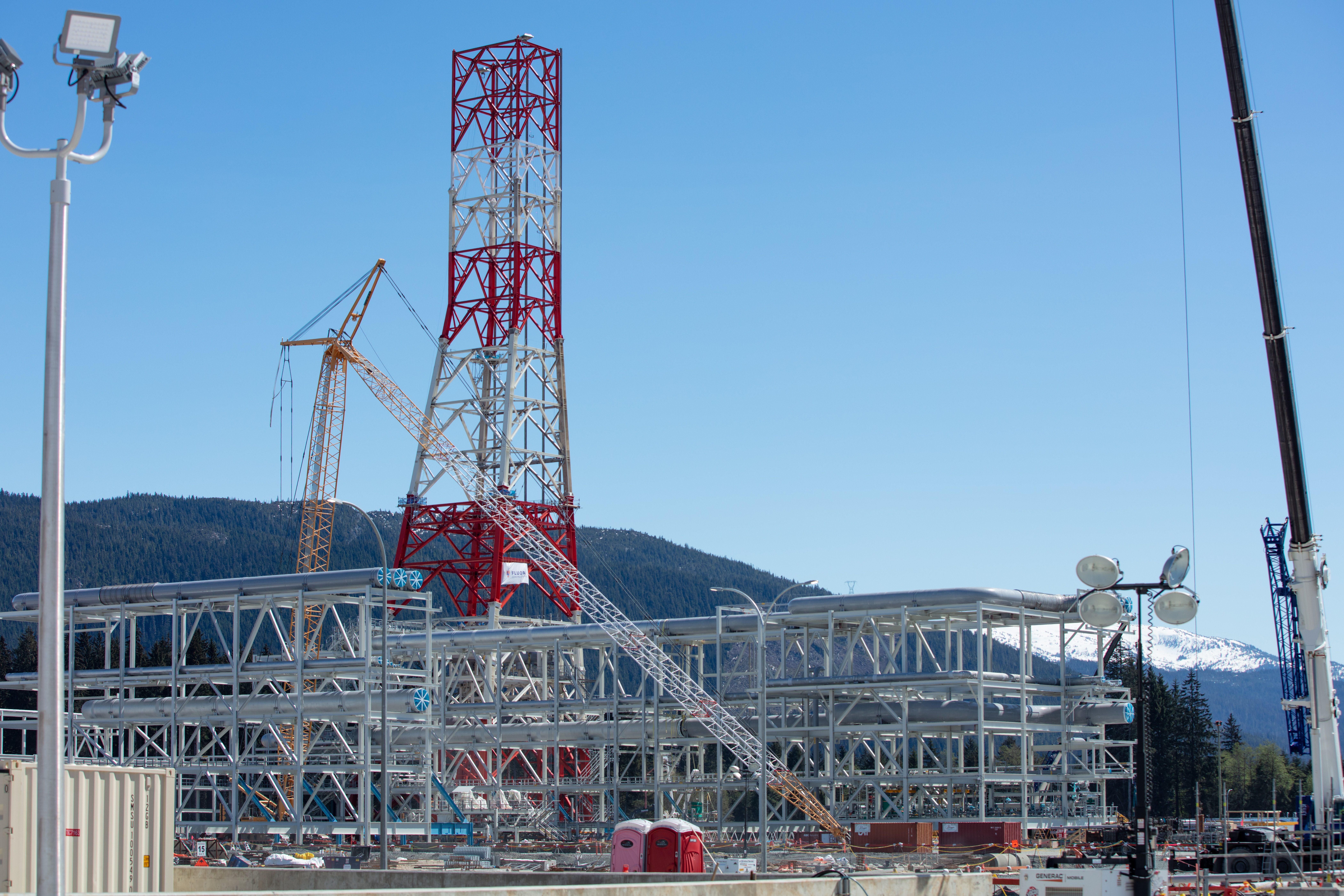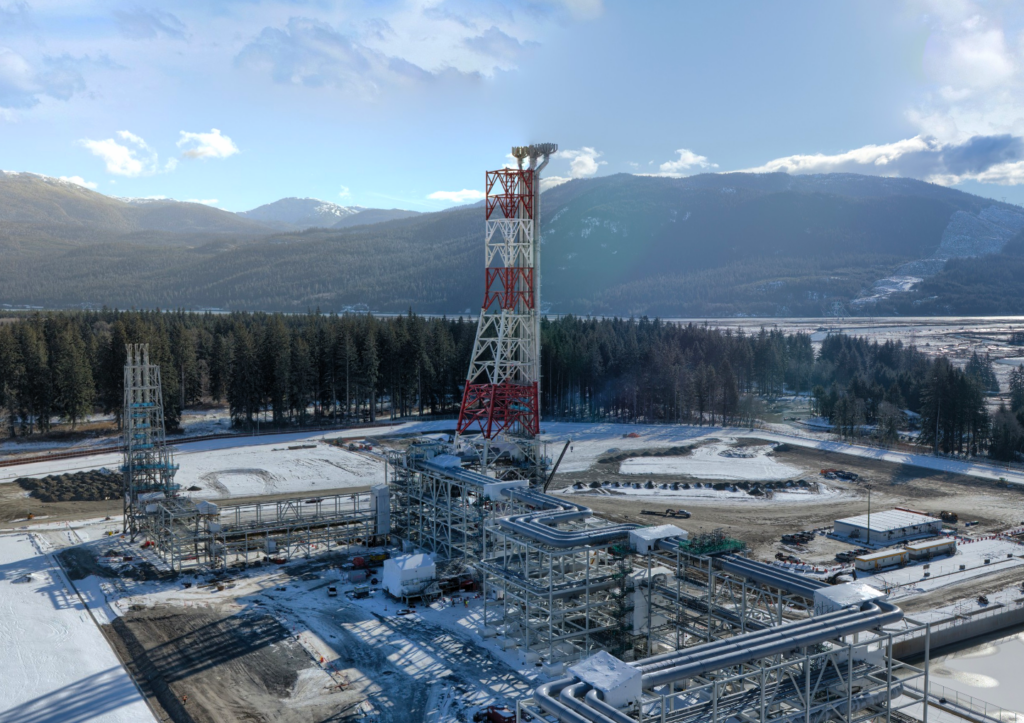
Safe Start-Up Activities
With operations on the horizon, LNG Canada is preparing to begin its safe start-up program. This will include the flaring of natural gas.
3 Things to Know About Flaring at the LNG Canada Facility
- Flaring is normal during facility start-ups and shutdowns but occurs much less frequently during steady operations. We anticipate flaring at the LNG Canada facility to begin in 2024.
- Flaring is a critical safety system and part of safe facility operations — it provides a way to combust natural gas when equipment maintenance is required, or when a shutdown occurs. Flaring is a safe outlet for natural gas and is provincially regulated.
- When our facility starts up for the first time, an elevated flare flame will be visible, and there may be instances of associated visible smoke. This is expected and part of safely starting up our LNG export facility. As the facility’s equipment settles into its regular operating range, flaring frequency along with any associated visible smoke will occur much less frequently.

Lower Dyke along the Kitimat River, Kildala School, Albatross Avenue Park, Strawberry Meadows and Coghlin Park.
Kitamaat Village soccer field and a pull-out along the Kitamaat Village Road.
Frequently Asked Questions About LNG Canada’s Flaring Activities
What is flaring?
Flaring is the controlled combustion of natural gas, with a visible flame. It’s something required during the start-up phase of a facility like ours, and occasionally during regular operations. It’s safe, controlled and provincially regulated.
Why does LNG Canada need to flare?
A flare functions as a safety critical relief device for our LNG facility. Hydrocarbons in the flare system are ignited via a small continuous flame (the flare pilot) at the flare tip, located at the top of the flare derrick, or tower. The
system is designed to provide safe, reliable, and efficient combustion of hydrocarbons so the hydrocarbons do not escape into the atmosphere.
Will LNG Canada provide notice ahead of a flaring event?
Yes. LNG Canada has a duty to notify the Haisla Nation, the District of Kitimat, and the Regional District of Kitimat-Stikine 24 hours in advance of a planned flaring event, and within 24 hours of an unplanned flaring event.
When will flaring occur at the LNG Canada facility?
During our commissioning and start-up activities, a period of continuous flaring will occur while systems are tested. Flaring in the commissioning and start-up process is expected to commence in the second quarter of 2024.
Once commissioning and start-up activities are complete, we’ll enter the early operations stage. Flaring will be intermittent as the facility is fine-tuned.
In regular operations, flaring will occasionally occur during planned maintenance activities, turnarounds, and in the event of an emergency. Emergency flaring occurs when safety controls within the LNG facility are enacted to depressurize equipment to avoid possible injury or property loss resulting from explosion, fire, or equipment failure. The flare safely combusts excess gas that could otherwise pose potential risks to personnel, the public or the environment.
How are the LNG Canada emissions, including flaring, regulated?
LNG Canada has applied to the BC Energy Regulator for two waste discharge authorization permits for the operations of
the LNG facility:
• Air – For the disposal of air emissions into the atmosphere
• Effluent – For the disposal of liquid waste into Douglas Channel via a marine outfall
A waste discharge authorization is written permission to release waste into the environment. Under the BC Environmental Management Act, waste can be introduced into the environment while conducting a prescribed
industry, trade or business with a valid and subsisting permit or approval. “Waste” is defined in the BC Environmental Management Act, and includes, among other things, certain air contaminants and effluent that will be associated with the operation of the LNG Canada facility.
The BC Energy Regulator has the authority to issue these waste discharge authorizations. It is through those authorizations that the BC Energy Regulator ensures measures are in place to minimize air emissions by including
permit condition requirements limiting the release of air contaminants.
To date, the BC Energy Regulator has involved the Ministry of Environment and Climate Change Strategy’s air specialists in the review of LNG Canada’s air permit application materials.
What does the LNG Canada flare system consist of?
The LNG Canada facility has two derrick structures, or towers, to support three flares and nine liquid burners, with networks of flare headers collecting gases that are continuously purged with nitrogen to avoid air ingress into the flare header. The vapour flare derrick is 122 meters in height; and the liquid burner flare derrick is 60 meters in height.
A continuous “flare pilot” is supplied by fuel gas that provides a continuous ignition source. Any gas sent to the flare because of upset conditions is immediately combusted.
What type of emissions and in what concentrations are expected from flaring?
The natural gas that is received at the LNG Canada facility and processed into liquified natural gas has the same composition as the natural gas used in homes for heating and cooking.
Air pollutants from the flare are a result of combustion of natural gas. These air pollutants, which will be regulated under the Waste Discharge Authorization issued by the BC Energy Regulator to LNG Canada, are carbon monoxide (CO), nitrous oxides (NOx), fine particulate matter (PM10, PM2.5) and sulphur dioxide (SO2). Hydrocarbon combustion also produces carbon dioxide (CO2) which is a greenhouse gas but not an air pollutant that adversely impacts human health.
LNG Canada’s flaring system is designed to operate according to industry leading standards. This ensures that byproducts of incomplete combustion, such as coarse and fine particulate matter (PM10, PM2.5), are released at
extremely low quantities.
Emissions from flaring events are included in LNG Canada Waste Discharge Authorization application materials that currently are under review by the BC Energy Regulator.
Could flaring cause a fire adjacent to the LNG Canada site?
Flaring will not produce sparks or embers that could travel under wind conditions and ignite buildings or vegetation adjacent to the LNG Canada facility. Any risk of an adjacent fire due to flaring activities would be related to the flare’s “thermal radiation.” A general guideline is that a thermal radiation of 25 to 30 kW/m2 is required for spontaneous ignition from wood.
As set out in B.C.’s Energy Resource Activities Act (BC Liquefied Natural Gas Facility Regulation), LNG Canada’s flare system meets the thermal radiation design requirement maximum of 5.0 kW/m2 at the
fence line, which is well below the general guideline for spontaneous ignition from wood.
Will flaring produce light pollution or glare?
During flaring activities, people will see an elevated flare flame. Noticeable changes in sky glow may occur during intermittent operation of the flare during commissioning.
Will the LNG Canada flare derrick affect air navigation?
While the LNG Canada facility is not located in restricted air space, the 122-meter flare derrick is considered an obstruction to air navigation. It is permitted by NAV CANADA and is equipped with warning lights, which are always visible, and paint markings. The flare derrick will be indicated on Visual Flight Rules (VFR) Navigation Charts by NAV CANADA. The flare derrick and other site infrastructure will not impede medical evacuations by helicopter.
Will flaring produce noise?
During some flaring events, LNG Canada anticipates that the flare will emit audible noise. LNG Canada has undertaken noise modelling to understand potential community impacts. The result of this modelling determined
that LNG Canada flaring events would not have an adverse impact in neighbouring residential communities and will conform to the B.C. Noise Control Best Practices Guideline.
The modelling results found that communities closest to the facility are unlikely to experience noise greater than experienced on a typical quiet street.
Who is accountable to ensure LNG Canada does what it says in its waste discharge authorization permits?
LNG Canada will be required to understand, maintain, and comply with all conditions in the waste discharge authorization permit. Depending on the permit’s terms and conditions, LNG Canada may be required to submit routine
reports of data and documentation as well as self-disclose non-compliances to the BC Energy Regulator.
The BC Energy Regulator ensures compliance through the proactive administration of inspections or permit holder activities, audits, and management of alleged non-conformances. For more information about compliance and enforcement, please refer to the BC Oil and Gas Compliance and Enforcement website.
Does LNG Canada have a response plan in the event of an emergency situation at its site?
Prior to start-up, LNG Canada must have in place an Emergency Response Plan approved by the BC Energy Regulator ensuring that our activities are carefully managed with health, safety and care for the environment.
LNG Canada has more than 100 response team members to support our safe start-up and operations.
Download safe start-up factsheets here
